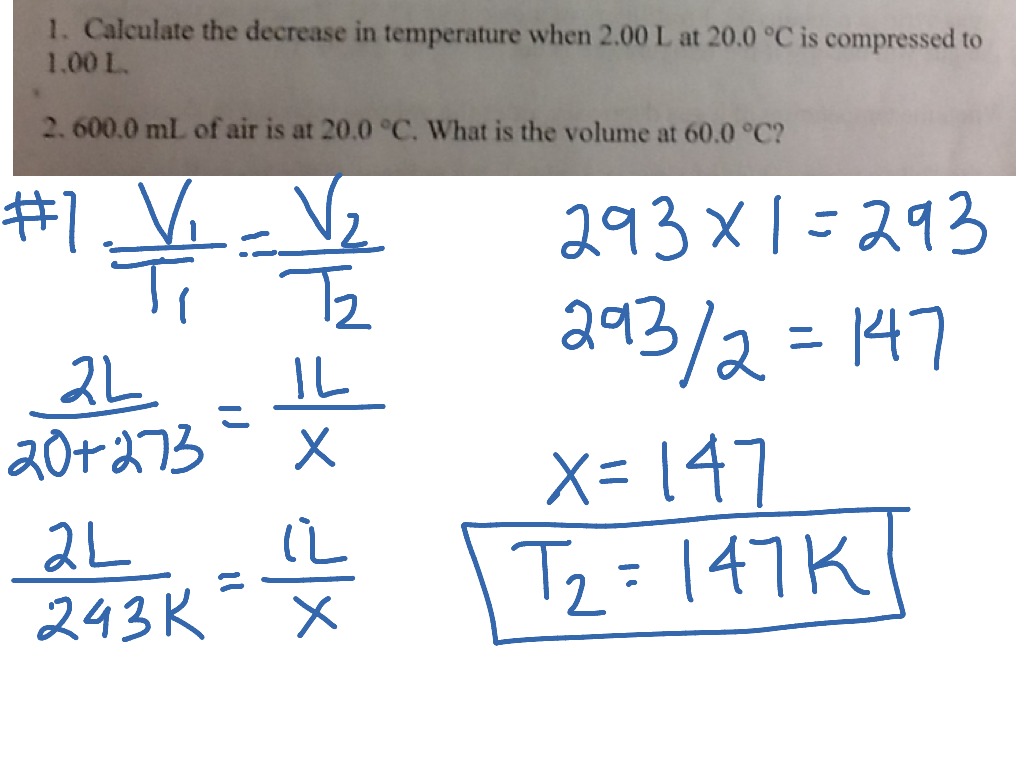Example For Charles Law - Charles Law is an important scientific principle that explores the relationship between temperature and volume of gas. It states that at a constant pressure, the volume of a gas increases or decreases in direct proportion to its temperature. This law, named after the French physicist Jacques Charles, can be expressed mathematically as V1/T1 = V2/T2, where V1 and T1 represent the initial volume and temperature of the gas, and V2 and T2 represent the final volume and temperature of the gas, respectively.
Understanding the Charles Law Equation
What the Variables Mean
The Charles Law equation may look complex at first glance, but breaking it down helps to understand the individual components. The V stands for volume, which is the three-dimensional space that the gas occupies. The T stands for temperature, which is the measure of the average kinetic energy of the gas particles. Therefore, when the temperature of the gas is increased, the particles move faster and collide more frequently with each other and the container, causing the volume to expand. Likewise, when the temperature of the gas is decreased, the particles move slower and collide less frequently, causing the volume to contract.
How to Use the Charles Law Equation
The Charles Law equation can be used to predict the final volume of a gas if the initial volume and temperature are known, or to calculate the initial volume or temperature if the final volume and temperature are known. For example, suppose a gas sample initially occupies 10 liters at a temperature of 25 degrees Celsius. If the temperature is raised to 50 degrees Celsius while maintaining a constant pressure, what will be the new volume of the gas?

To solve this problem using the Charles Law equation, we can plug in the known values of V1 (=10 liters) and T1 (=25 + 273.15 Kelvin) and the unknown value of T2, which equals 50 + 273.15 Kelvin. Then, we can solve for V2 by cross-multiplying and simplifying the equation:
V1 / T1 = V2 / T2
V2 = V1 x T2 / T1
V2 = 10 x (50 + 273.15) / (25 + 273.15)
V2 = 12.3 liters
Therefore, the final volume of the gas is 12.3 liters.
Charles Law Examples and Problems
Example 1: Balloon in freezer
A latex balloon initially has a volume of 2.5 liters at room temperature (25 degrees Celsius) and standard pressure (1 atm). If the balloon is placed in a freezer at -15 degrees Celsius, what will be its new volume?
To solve this problem, we can again use the Charles Law equation with V1 = 2.5 liters and T1 = 25 + 273.15 Kelvin and T2 = -15 + 273.15 Kelvin:

V1 / T1 = V2 / T2
V2 = V1 x T2 / T1
V2 = 2.5 x (258 / 298.15)
V2 = 2.2 liters
Therefore, the new volume of the balloon in the freezer is 2.2 liters.
Example 2: Piston and cylinder
A gas initially occupies 1.5 liters at a pressure of 2 atm and a temperature of 25 degrees Celsius. The gas is then compressed by a piston to a volume of 0.5 liters while maintaining the same pressure. What is the final temperature of the gas?
This problem requires a different equation, known as Gay-Lussac's Law, which states that the pressure and temperature of a gas are directly proportional to each other at a constant volume. Therefore, we can set the initial and final conditions of the gas to a ratio:
P1 / T1 = P2 / T2
Where P1 = P2 = 2 atm, V1 = 1.5 liters, and V2 = 0.5 liters.
T2 = P2 x T1 / P1 x V2 / V1
T2 = 2 x (25 + 273.15) / (1 x 0.5 / 1.5)
T2 = 200.6 Kelvin
Therefore, the final temperature of the gas is -72.6 degrees Celsius.
Tips and Ideas for Memorizing the Charles Law Equation
Like any scientific principle, memorizing the Charles Law equation can be challenging. Here are some tips and ideas to make it easier:
- Associate the letters V, T, and P with their respective meanings and units, and practice using them in context.
- Draw diagrams or graphs to visualize the relationship between volume and temperature.
- Create mnemonic devices or acronyms to remember the equation, such as "Very Temperamental Vandals Like To Punch Backwards", where V = volume, T = temperature, and V/T = constant.
- Practice solving example problems and checking your answers with a calculator or online tool.
How to Apply the Charles Law Equation in Real Life
The Charles Law equation has many practical applications in everyday life, such as:
- Designing and maintaining HVAC (heating, ventilation, and air conditioning) systems in buildings and homes.
- Calculating the pressure and temperature changes inside a car tire or scuba tank due to changes in altitude or volume.
- Producing and storing gases in industrial processes, such as natural gas, hydrogen, and oxygen.
- Manufacturing and testing gas-powered appliances, such as stoves, grills, and heaters.
By understanding and applying the Charles Law equation, you can gain a deeper appreciation for the behavior of gases and their impact on our daily lives.
View more articles about Example For Charles Law


